Field Notes
012
When Past And Present Collide!
Floods Threaten Ancient Assyrian City
Rising waters from a new dam scheduled to open in 2007 will submerge many of the temples, ziggurats and residences of Ashur, an ancient Assyrian city about 190 miles north of modern Baghdad, Iraq.
The Makhul dam will span the Tigris River, generating electricity and creating a 20-mile-long reservoir that will store water for Iraqi towns and agricultural areas during the dry season. The Iraqis claim that this massive project was necessitated by “hostile” Turkish neighbors who diverted water from the sources of the Tigris.
Massive hydroelectric projects are an accelerating trend in the Fertile Crescent, as developing nations struggle to build their economies. Turkey’s own thirst for reliable 013sources of water and electricity led it to construct the $1.5 billion Birecik Dam (below), which some two years ago drowned Zeugma, a 2,300-year-old Greco-Roman city on the banks of the Euphrates.

Archaeologists had frantically surveyed and excavated many of Zeugma’s villas and mosaics before floodwaters covered much of the site. (See Jessica A. Meyerson, “After the Flood,” AO 03:06)

The ruins of Ashur—the Assyrian empire’s first political capital and a religious center from 2000 to 600 B.C.—lie on a promontory above the Tigris River (see
Iraqi archaeologists have proposed building a protective dam around the site, but there is little likelihood that Saddam Hussein’s government will fund such a project. The current political climate makes the possibility of an international rescue dig an even longer shot. Alas, much of Ashur may only be frequented by scuba divers in the near future.
012
Current Exhibitions
In the Fullness of Time: Masterpieces of Egyptian Art from American Collections
Salem, OR
(503) 370–6855
Through January 4, 2003
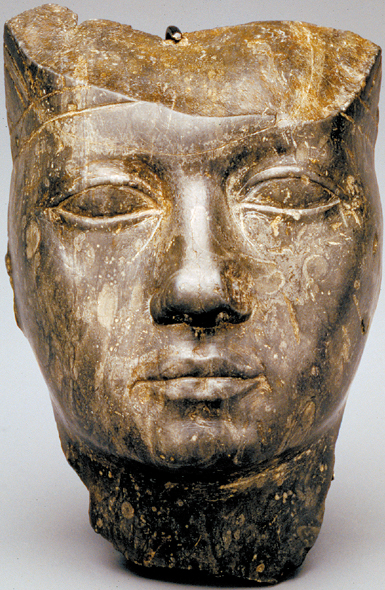
This exhibition presents a rare opportunity for museum-goers in the western states to see 48 masterpieces of Egyptian art, culled from such distinguished collections as the Museum of Fine Arts, Boston, and New York’s Metropolitan Museum of Art. Paintings, sculptures (including the bust of Pharaoh Amenemhet III (1844–1797 B.C.) above, reliefs and jewelry will be on display. An accompanying lecture series will be presented by some of the foremost Egyptologists in the United States.
Worlds Intertwined: The Etruscans, Greeks and Romans
Philadelphia, PA
(215) 898–4000
Opens March 2003
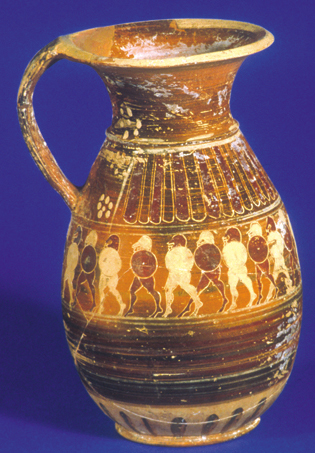
The University of Pennsylvania Museum is celebrating the end of a ten-year renovation of its classical galleries by exploring the secrets of one of history’s most enigmatic peoples, the Etruscans of central Italy. Visitors will see rare artifacts from Etruscan tombs, including carved sarcophagi and dramatic bucchero ware (fired pottery made to resemble metalwork, as in the sixth-century B.C. jug above), and hear audio clips of the Etruscan language.
Nomadic Art of the Eastern Eurasian Steppes: The Eugene V. Thaw and Other New York Collections
New York, NY
(212) 570–3951
October 1, 2002 to January 5, 2003
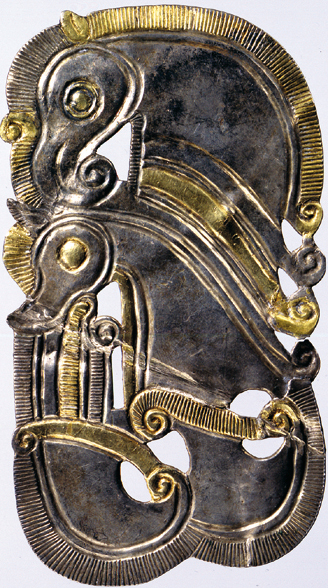
This exhibit showcases horse harnesses, chariot fittings and weapons dating from the tenth century B.C. to the second century A.D.—the distinctive art produced by the nomads of ancient Eurasia. The nomads’ bold designs—including dynamic depictions of horses (above)—influenced the art of the more sedentary cultures of the region.
013
Glass of Imperial Rome from the John F. Fort Collection
Houston, TX
(713) 639–7540
Through October 20, 2002
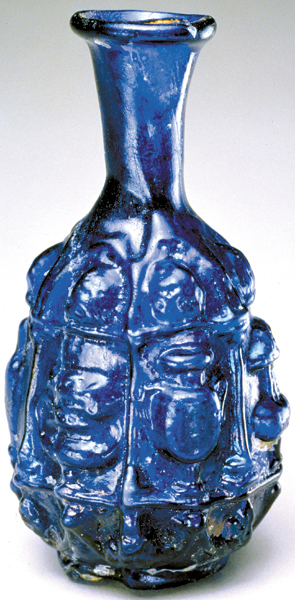
In the first century B.C., inventive Roman glassmakers discovered that they could blow liquid glass through a pipe to produce a variety of shapes and sizes. Their handiwork soon became a ubiquitous feature of Roman life. More than 100 Roman-period glass objects—from simple bowls and plates to more intricate flasks, such as the first-century A.D. bottle from Sidon (above) and multicolored unguentaria (perfume bottles)—are on view in the Caroline Wiess Law Building.
Magna Graecia: Greek Art from South Italy to Sicily
Cleveland, OH
(216) 421–7340
October 27, 2002 to January 5, 2003
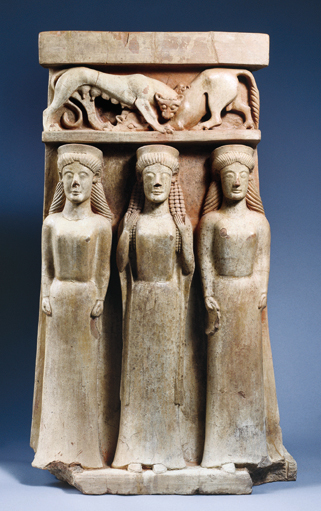
For the first time, the treasures of Magna Graecia—the Greek colonies that flourished in southern Italy and Sicily before the rise of Rome—have come to North America. Highlights include the terracotta altar with three female figures shown above, produced during the fifth century B.C. in Gela, Sicily.
Egyptian Department Centennial
Boston, MA
(617) 267–9300
October 14, 2002 (Columbus Day)

One hundred years after the official founding of its Egyptian Department, Boston’s Museum of Fine Arts will be hosting a day-long open house, allowing visitors to view its renowned Egyptian collection for free. The newly conserved, late-seventh-century B.C. stone sculpture of the god Osiris (above) will be on display (sporting his long-lost feet, which were acquired by the museum after a century of searching), as well as the magnificent gold and silver pectoral with inlays of carnelian and glass shown below, created in the first half of the second millennium B.C.
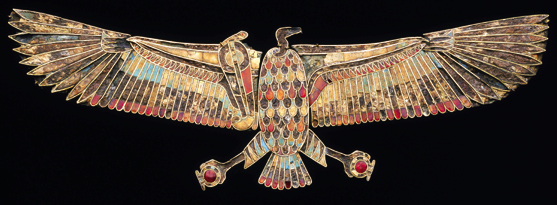
014
Did History Begin at Sumer?
Three seasons of excavations at Tell Hamoukar—about five miles from the Iraqi border in northeastern Syria—have overturned traditional assumptions about the rise of civilization in the ancient Near East.
It has long been thought that urban civilization first developed in Sumer during the mid-fourth millennium B.C. and then spread, over the next 1,000 years, to northern Mesopotamia, Syria and the rest of the Near East. Now, as a result of excavations led by McGuire Gibson of the University of Chicago’s Oriental Institute and Amr al-Azm of the Syrian Directorate General of Antiquities, it appears that urban centers in Syria arose contemporaneously with—but independently from—the Sumerian city-states of southern Mesopotamia.
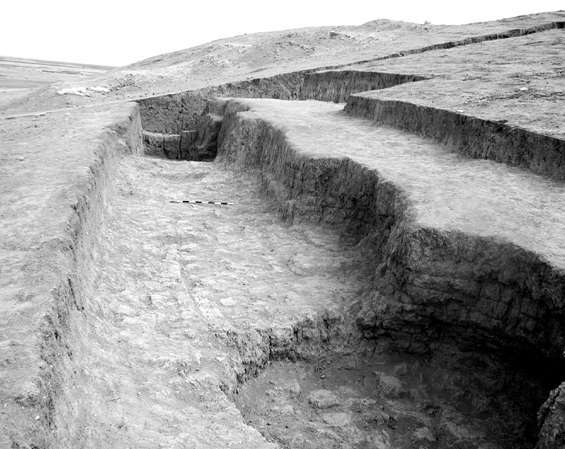
Around 3500 B.C., the residents of Tell Hamoukar lived in a well-organized 33-acre settlement. To protect their city, they built a mudbrick wall (above), 65 feet of which have been uncovered. They also developed an organized division of labor, as indicated by objects used for large-scale food preparation, such as huge cooking pots (some still containing traces of wheat, barley, oats and animal bones) and five domed ovens in a single building (perhaps a bakery).
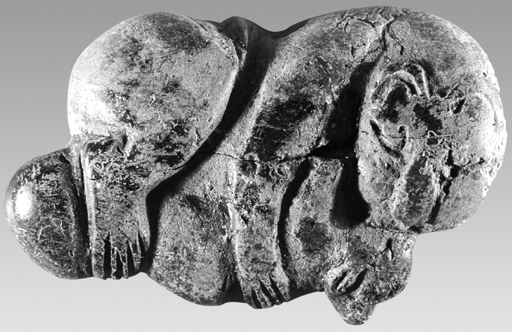
Although the Hamoukarians had no writing, they did use seals to indicate ownership. More than 80 seals have been recovered from the site, whose decorations range from simple, incised cross-hatchings to elaborate animal scenes—such as the one above, showing a lion attacking a goat.
Another sign of the city’s urbanity is the fine ceramic ware created by Tell Hamoukar’s potters. Some of the jars found in the excavations have walls as thin as an ostrich eggshell.
015
Brush up on Your Sumerian
Ancient Archives on the Web
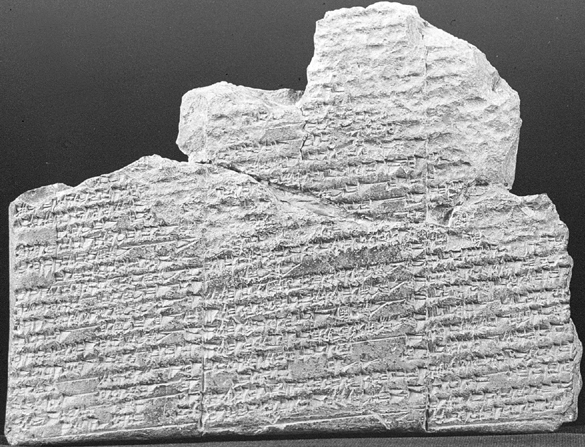
A group of scholars is working to catalogue and photograph all ancient Near Eastern cuneiform texts from the third millennium B.C.—an estimated 120,000 tablets now scattered in museums, libraries and private holdings around the world. These photographs will then be posted on the World Wide Web, so that everyone, scholars and laymen alike, will have access to them.
Robert Englund, an Assyriologist with the University of California at Los Angeles and director of the Cuneiform Digital Library Initiative, reports that 60,000 texts are already online and that the remaining 60,000 may be added within the next two years.
Until recently, scholars documented texts the old-fashioned way, by painstakingly copying, transliterating and translating inscriptions. The new internet technology allows the virtual Cuneiform Digital Library to pool resources from all over the world: the Hermitage Museum in St. Petersburg, the Louvre in Paris, the Vorderasiatisches Museum in Berlin, Yale University’s Babylonian Collection, and the University Museum of the University of Pennsylvania.
015
The Amesbury Archer
Will an Impressive Bronze Age Burial Solve the Mystery of Stonehenge?
A Bronze Age burial of unprecedented richness was uncovered by archaeologists last May just a few miles east of Stonehenge, the 5,000-year-old megalithic monument on England’s Salisbury Plain.
The grave in Amesbury, Wiltshire, contained the remains of a man 35 to 50 years old. Since he was buried with such archery gear as stone arrowheads and slate wrist guards that protected his arm from the recoil of his bow, modern archaeologists have dubbed him the Amesbury Archer.
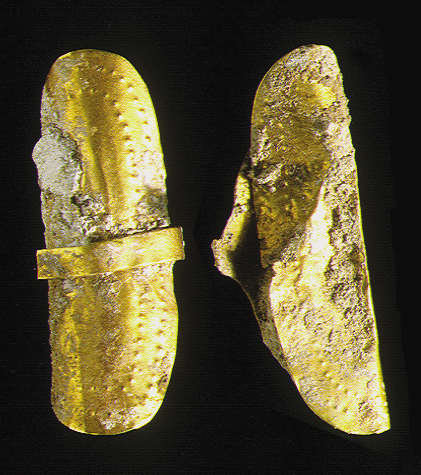
The burial site (shown below) also included scores of precious objects, indicating the archer’s high status. These include pottery beakers, a bone pin, boars’ tusks, flints, a deer spatula, three copper knives, a whetstone and a rare pair of gold earrings (above) designed to wrap around the ear.
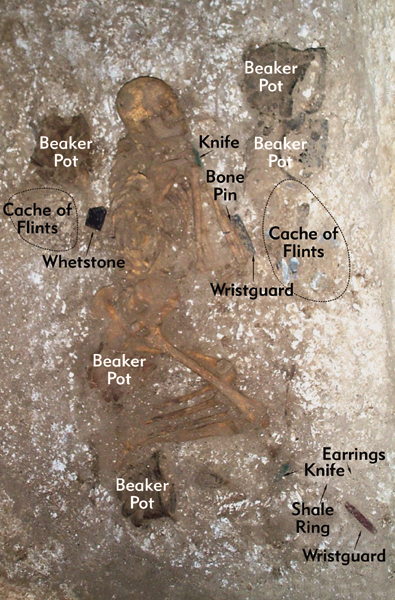
The Amesbury Archer died around 2300 B.C., when Stonehenge’s most spectacular building sequence was underway. Massive stones were brought to the site from as far away as Wales and assembled into an enormous stone circle constructed of posts and lintels.
Is there a link between the archer and the people who erected the stone circle? Andrew Fitzpatrick, the Wessex Archaeology project manager in charge of the Amesbury site, told Archaeology Odyssey that there probably is a connection and that the discovery of the archer throws a completely different light on Stonehenge. “We thought that we had chiefs during this period, but it now looks as if an individual from a different stratum of society—perhaps even a king—wielded authority in the area.”
016
To Dig or Not to Dig?
Herculaneum Library Excavation Shelved (For Now)
Buried beneath hardened volcanic mud from two eruptions of Mt. Vesuvius (79 A.D. and 1631 A.D.), Herculaneum’s Villa of the Papyri contains the only extant archive containing works of first-century B.C. Greek prose—including the only known writings of the Epicurean philosopher Philodemus (a papyrus fragment of his treatise On Rhetoric I is shown below).
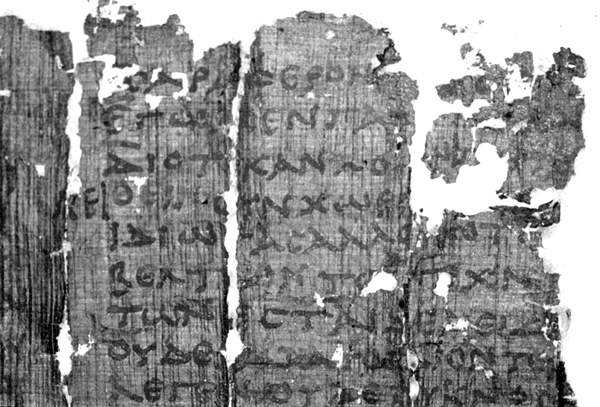
Many scholars believe that the villa also contains an as-yet-undiscovered archive of Latin works, as Roman libraries generally had both Latin and Greek wings. See “Excavate Herculaneum!” AO 01:01. But excavation of the villa has been halted—a decision exposing a major rift between classicists and archaeologists.
In a report published in the London Times last May, eight British and American classicists pleaded with authorities to resume excavation of the Villa of the Papyri after a four-year hiatus caused by a lack of funding. Earlier that month, Pietro Giovanni Guzzo, the superintendent at Pompeii and Herculaneum, had decided not to allow any further digging until a feasibility study is completed and a commitment made to conserve the 1,800 papyri that have already been uncovered.
Those in favor of continued excavation hope that the sumptuous villa—which overlooked the Bay of Naples and belonged to Julius Caesar’s father-in-law, Lucius Calpurnius Piso Caesonius, a highly literate man who befriended poets and philosophers—will yield works by Cicero, Lucretius, Virgil, Horace and Livy. They point out that excavations in the early 1990s revealed that at least four levels of the villa remain unexplored. Massive wooden doors embellished with small round windows of precious glass have been spotted on the second level, offering the tantalizing possibility that the portals lead to a very important part of the house, perhaps another wing of the library.
Proponents of excavation are also concerned that flooding at the site, which has increased since the 1990s when a trench was dug below the water table, further endangers any remaining papyri. They also believe that continuing seismic activity around the Bay of Naples may well herald another eruption of Mt. Vesuvius, which could bury the villa under a nearly impenetrable layer of volcanic debris.
The buried villa was first excavated in the 1750s by Charles III, the Bourbon king of Naples, whose engineers constructed a network of mine-like shafts. Numerous bronze and marble sculptures, as well as mosaics and carbonized papyri, were removed from the site via these tunnels. Unfortunately, workers discarded many of the papypri, thinking that they were simply sticks of charcoal.
Excavations conducted between 1991 and 1998 exposed the villa’s atrium. Work was launched this summer to clear the atrium’s mosaic floor of weeds, trash and pigeon droppings.
But it is the condition of the recovered papyri—which during the 79 A.D. eruption were charred by hot gas and then compressed into charcoal-like lumps by the great weight of the volcanic debris—that lies at the heart of the controversy.
Those who want to resume excavation believe that new technologies, including multi-spectral imaging, may enable scholars to decipher inked writing on even the blackest papyri. On the other hand, excavation opponents note that only half of the recovered papyri have been read. Exposing more of the fragile texts to the air, they say, will only cause further deterioration.
According to Andrew Wallace-Hadrill, director of the British School at Rome and chairman of an international scientific committee responsible for the Herculaneum Conservation Project, “The papyri are safe and will remain so until we start messing around with them. Any object that is still under the material remains of a volcanic eruption is in a stable state.”
017
Welcome to the Family!
Have Scientists Discovered the Oldest Human?
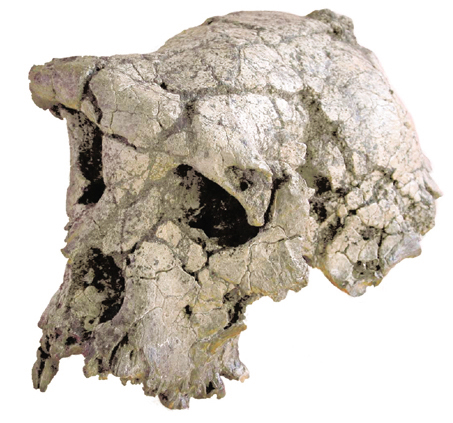
An international team of excavators has unearthed a six- to seven-million-year-old human skull in northern Chad that some scientists are hailing as the “missing link” in human evolution.
Last year, excavators in Chad’s Djurab Desert, led by Michel Brunet of the Université de Poitiers in France, found an intact cranium, two lower jaw fragments and several teeth. This creature, dubbed “Toumaï” (“Hope of Life” in a central African dialect), had a small, chimp-like brain, but its facial features would have appeared more-or-less human.
Although paleoanthropologists had previously uncovered ape skulls that were eight to nine million years old and human-ancestor skulls dating to three to four million years ago, they hadn’t found any significant skull material from the intervening five-million-year period until now.
Leading scientists have been quick to acknowledge the importance of Brunet’s find. According to Harvard’s Daniel Lieberman, the discovery “will have the impact of a small nuclear bomb.”
So far, however, there is no consensus among scientists whether or not Toumaï represents a new species of hominid, a new species of ape, or the last common ancestor of humans and chimpanzees. Two French experts suggest that the fossil may simply point to an ordinary female gorilla. Perhaps the most intriguing question about Toumaï—Did the creature walk upright?—will have to go unanswered, because excavators did not recover any limbs.
If Toumaï turns out to be our earliest relative, it is surprising that he/she lived in central, rather than eastern, Africa. The excavation site in the Djurab Desert lies 1,500 miles to the west of the Rift Valley, where the search for human origins has been focused for the past 40 years following Louis and Mary Leakey’s discoveries of early hominid fossils in Tanzania. Quite possibly, the so-called “cradle of humanity” is far, far larger than anyone ever suspected.
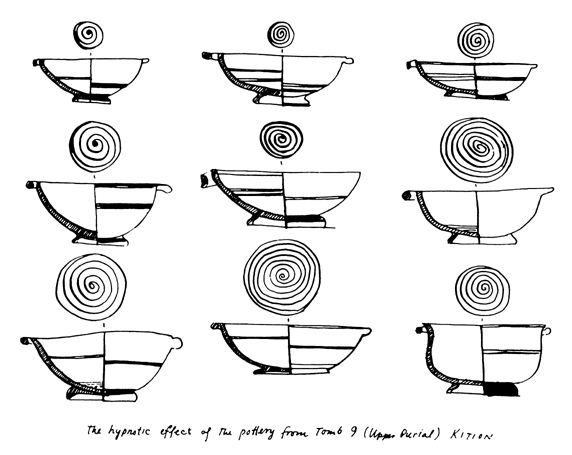
018
Long-Lost Amphitheater
London’s Roman Past Recovered

After 1,600 years, crowds are returning to an ancient gathering place in the heart of London. The remains of a 500-seat amphitheater, first uncovered in 1988 by construction crews expanding London’s Guildhall Art Gallery, have been displayed in situ beneath the gallery since June.
Until now “virtually no surviving Roman remains” have been on display in London, according to archaeologist Nick Bateman, who spent five years uncovering the site.
London’s first amphitheater was built of wood in 70 A.D., when Rome occupied the walled town of Londinium on the Thames. By the early second century, the structure’s walls and entranceways were rebuilt in tile and stone. The building remained in use until the fourth century, when Rome abandoned Britain.
While Bateman and his ten-member team were excavating the site, engineers designed ways to incorporate the finds into the Guildhall’s galleries. Today the excavated eastern portal, likely used by gladiators and animals to enter the sandy arena, appears in a dim room in the gallery’s basement. One stone on the threshold is scarred by rectangular grooves, indicating that there may have been a trap door for wild animals.
The theater’s tiers of seats are suggested by illuminated lines extending across the dark wall of the subterranean room. Computer-generated wire-frame figures strike gladiatorial poses, creating a stark minimalist effect (above).
Scholars had long speculated that Londinium had an amphitheater—the town was one of the largest in the Roman province of Britannia and one of the empire’s most significant settlements outside the Mediterranean. But it wasn’t until Bateman’s team dug four trenches to expose more ruins that they had proof: an oval-shaped wall revealing a structure about 330 feet long by 260 feet wide.
“People had been searching for the amphitheater for hundreds of years—and suddenly I was standing in it,” Bateman recalled. “The most amazing thing was that no one realized it was there. After all, how can you lose a building the size of a football pitch?”
017
OddiFacts
Peppermania
Apparently the ancient Visigoths had a yen for spicy food. When their king Alaric threatened to sack Rome in 408 A.D., he not only demanded all the city’s gold, silver, movable property and barbarian slaves, but he also demanded 3,000 pounds of pepper from the Roman populace. All that tribute was nothing to sneeze at—it delayed the final sack of Rome for two years.
When Past And Present Collide!
Floods Threaten Ancient Assyrian City
Rising waters from a new dam scheduled to open in 2007 will submerge many of the temples, ziggurats and residences of Ashur, an ancient Assyrian city about 190 miles north of modern Baghdad, Iraq.
You have already read your free article for this month. Please join the BAS Library or become an All Access member of BAS to gain full access to this article and so much more.
